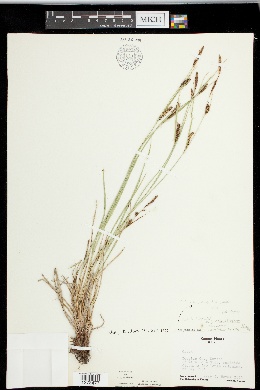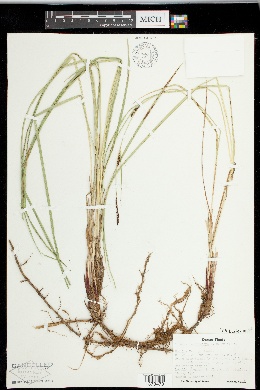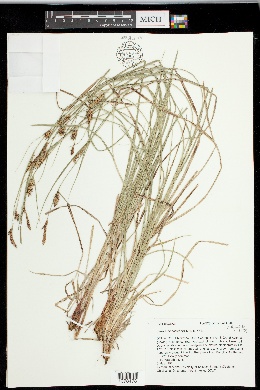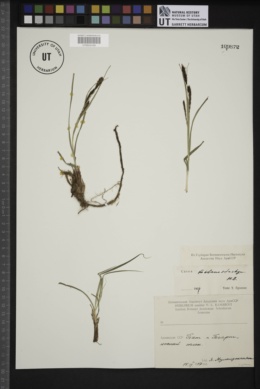Carex melanostachya
|
|
|
|
Family: Cyperaceae
Great Plains Sedge
|
Plants colonial; rhizomes long-creeping. Culms central, slender, trigonous, 25-65 cm, ± scabrous-angled. Leaves: basal sheaths reddish purple, apex of inner band finely ciliate; ligules 0.7-1.9 mm; blades green, M-shaped, not septate-nodulose, 1.6-3.5(-4) mm wide, smooth abaxially, glabrous or, sometimes, lightly pubescent on apex of inner band of distal sheaths. Inflorescences 6-20 cm; rachis beyond proximal pistillate spikes sharp-angled, finely scabrous; proximal (1-)2(-3) spikes pistillate, not or barely overlapping, ascending; distal spikes erect; terminal 1-3 spikes staminate. Pistillate scales ovate, apex acute to acuminate-awned, glabrous, scabrous-ciliate apically. Perigynia ascending, ca. 14-18-veined near base, veins impressed, broadly ovoid, (4-)4.5-6.5 × 1.9-3.5 mm, dull, glabrous; beak 0.9-1.3 mm, bidentulate, teeth straight, 0.5-0.8 mm. Fruiting May-Jun. Ruderal in moist to wet roadside ditches and waste areas; 100-300 m; introduced; Kans., Nebr., Okla.; Eurasia. Carex melanostachya is a rare introduction from Eurasia, first discovered in the flora in Kansas in 1964 (R. L. McGregor et al. 1972). A previous report, as C. nutans Host, from the Montreal area is based on sterile specimens suspected to be of hybrid origin (J. Cayouette and P. M. Catling 1992). A similar taxon, C. songorica subsp. gotoi (Ohwi) Popov [C. gotoi Ohwi] was found once as a waif in Yonkers, New York, in 1895. It differs from C. melanostachya in having perigynia that are shorter, only 3-4 mm, shiny, purplish, and have raised veins.
Stems slender, mostly 3-6 dm, arising singly or few together from long rhizomes; lvs long and narrow, mostly 2-4 mm wide; bracts lf-like but scarcely or not at all sheathing, ±erect, the lowest one about equaling or somewhat surpassing the infl; terminal spike staminate, 2-3 cm, evidently pedunculate, or often with 1 or 2 shorter sessile ones at its base, the other 2 or 3 spikes a little more remote, pistillate, 1.5-3(-4) cm; pistillate scales castaneous, with a paler firm midrib prolonged as a short awn or cusp; perigynia plump, ellipsoid-trigonous, 3.5-5(-5.5) mm, firm and impressed-nerved at maturity, rather abruptly contracted to the short, evidently bidentate beak; achene trigonous. Wet grasslands and disturbed wet places; native of Europe, irregularly intr. in N. Amer., as in e. Kans. and near Montreal. (C. nutans Host, not J. F. Gmelin.) Gleason, Henry A. & Cronquist, Arthur J. 1991. Manual of vascular plants of northeastern United States and adjacent Canada. lxxv + 910 pp. ©The New York Botanical Garden. All rights reserved. Used by permission. |




















































